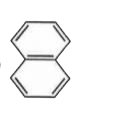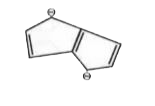Which of the following molecule is planar as well as polar :
PCl3
SF4
ClF3
None of these
The correct Answer is:C
To determine which of the following molecules is both planar and polar, we will analyze each molecule's hybridization, shape, and dipole moment.
1. Identify the Molecules: We need to analyze the given molecules one by one. Let's assume the molecules are phosphorus trichloride (PCl3), sulfur tetrafluoride (SF4), and chlorine trifluoride (ClF3).
2. Calculate Hybridization and Shape for PCl3:
- Valence Electrons: Phosphorus (P) has 5 valence electrons, and there are 3 chlorine (Cl) atoms, each contributing 1 electron.
- Total: 5 (P) + 3 (Cl) = 8 electrons.
- Hybridization: The number of hybrid orbitals (x) = 5 (valence electrons) - 0 (no charge) + 3 (monovalent atoms) = 4.
- Shape: With 3 bond pairs and 1 lone pair, the shape is trigonal pyramidal, which is non-planar.
3. Calculate Hybridization and Shape for SF4:
- Valence Electrons: Sulfur (S) has 6 valence electrons, and there are 4 fluorine (F) atoms.
- Total: 6 (S) + 4 (F) = 10 electrons.
- Hybridization: The number of hybrid orbitals (x) = 6 (valence electrons) - 0 (no charge) + 4 (monovalent atoms) = 5.
- Shape: With 4 bond pairs and 1 lone pair, the shape is seesaw, which is also non-planar.
4. Calculate Hybridization and Shape for ClF3:
- Valence Electrons: Chlorine (Cl) has 7 valence electrons, and there are 3 fluorine (F) atoms.
- Total: 7 (Cl) + 3 (F) = 10 electrons.
- Hybridization: The number of hybrid orbitals (x) = 7 (valence electrons) - 0 (no charge) + 3 (monovalent atoms) = 10.
- Shape: With 3 bond pairs and 2 lone pairs, the shape is T-shaped, which is planar.
5. Determine Polarity:
- For PCl3, the dipole moment is directed towards Cl, but due to its pyramidal shape, it is non-planar and thus non-polar.
- For SF4, the seesaw shape leads to cancellation of some dipole moments, resulting in a net dipole moment, but it is non-planar.
- For ClF3, the T-shaped structure has a net dipole moment directed towards the more electronegative fluorine atoms, making it polar.
Conclusion:
The molecule that is both planar and polar is ClF3.
Final Answer:
ClF3 is the correct answer.
---
- Valence Electrons: Phosphorus (P) has 5 valence electrons, and there are 3 chlorine (Cl) atoms, each contributing 1 electron.
- Total: 5 (P) + 3 (Cl) = 8 electrons.
- Hybridization: The number of hybrid orbitals (x) = 5 (valence electrons) - 0 (no charge) + 3 (monovalent atoms) = 4.
- Shape: With 3 bond pairs and 1 lone pair, the shape is trigonal pyramidal, which is non-planar.
- Valence Electrons: Sulfur (S) has 6 valence electrons, and there are 4 fluorine (F) atoms.
- Total: 6 (S) + 4 (F) = 10 electrons.
- Hybridization: The number of hybrid orbitals (x) = 6 (valence electrons) - 0 (no charge) + 4 (monovalent atoms) = 5.
- Shape: With 4 bond pairs and 1 lone pair, the shape is seesaw, which is also non-planar.
- Valence Electrons: Chlorine (Cl) has 7 valence electrons, and there are 3 fluorine (F) atoms.
- Total: 7 (Cl) + 3 (F) = 10 electrons.
- Hybridization: The number of hybrid orbitals (x) = 7 (valence electrons) - 0 (no charge) + 3 (monovalent atoms) = 10.
- Shape: With 3 bond pairs and 2 lone pairs, the shape is T-shaped, which is planar.
- For PCl3, the dipole moment is directed towards Cl, but due to its pyramidal shape, it is non-planar and thus non-polar.
- For SF4, the seesaw shape leads to cancellation of some dipole moments, resulting in a net dipole moment, but it is non-planar.
- For ClF3, the T-shaped structure has a net dipole moment directed towards the more electronegative fluorine atoms, making it polar.
The molecule that is both planar and polar is ClF3.
ClF3 is the correct answer.
Topper's Solved these Questions
- INORGANIC CHEMISTRYBOOK - ALLENCHAPTER - INORGANIC CHEMISTRYEXERCISE - COORDINATION COMPOUNDS & d-BLOCK COMPOUNDS
109 Videos
- INORGANIC CHEMISTRYBOOK - ALLENCHAPTER - INORGANIC CHEMISTRYEXERCISE - COORDINATION COMPOUNDS & d-BLOCK COMPOUNDS (MATCH THE COLUMN)
2 Videos
- INORGANIC CHEMISTRYBOOK - ALLENCHAPTER - INORGANIC CHEMISTRYEXERCISE - PERIODIC TABLE (MATCH THE COLUMN TYPE QUESTIONS)
5 Videos
- HYDROGENBOOK - ALLENCHAPTER - HYDROGENEXERCISE - EXERCISE-5
17 Videos
- Ionic EquilibriumBOOK - ALLENCHAPTER - Ionic EquilibriumEXERCISE - All Questions
37 Videos
Similar Questions
Knowledge Check
Which of the following is most polar?
A B
B C
C D
D
Which of the following molecule is non-polar & planar ?
View SolutionWhich of the following molecule is planar due to back bonding
View SolutionWhich of the following molecule has complete octet as well as non-polar
View SolutionWhich of the following is polar ? .
View SolutionWhich of the following is a planar molecule ?
View SolutionWhich one of the following is planar ?
View SolutionWhich of the following species is non- polar ?
View Solution
